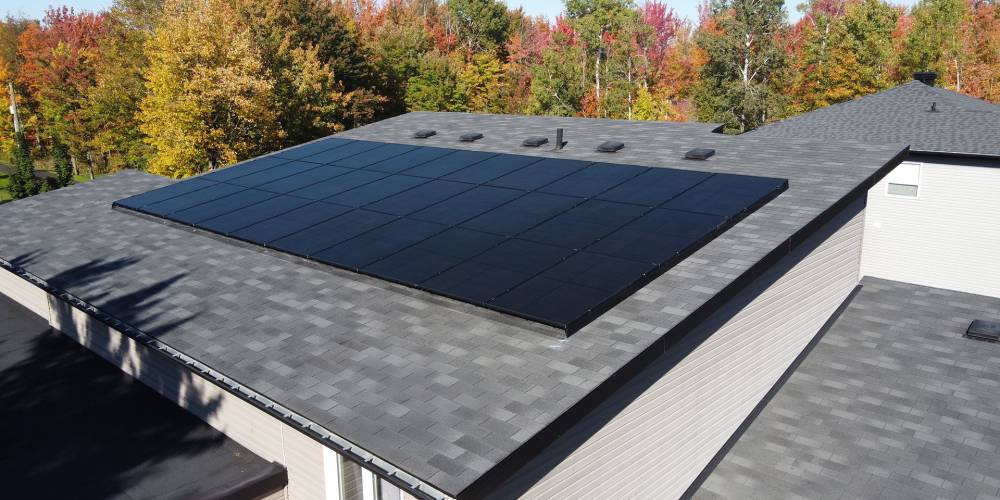We all know solar can help homeowners save money, but how does that actually happen? Is it the same for everyone? In today’s post, we’ll break down how solar savings work specifically for Ottawa homeowners in 2025, from bill reductions to long-term returns.

How does Solar save homeowners money?
Solar saves homeowners money in two main ways.
First, solar energy can be used directly by the home, reducing the amount of electricity that needs to be purchased from the utility. In other words, the home’s energy consumption from the grid will be lower than it was before solar was installed.
The second way solar provides savings is through the generation of Net Metering credits. In Ontario, when a home produces more solar power than it needs at a given time, the excess electricity is sent to the grid in exchange for a credit on the hydro bill. That extra power is redistributed to nearby homes through the local utility.
For example, if a home regularly used 1,600 kWh a month, but had a solar system generating 1,600 kWh a month.
- Solar Power Generated: 1,600 kWh
- Solar Power Consumed: 700 kWh
- Solar Power Exported: 900 kWh
- Grid Power Imported: 900 kWh
In this example, the homeowner would be billed for 900 kWh – 900 kWh = 0 kWh. This is a full month offset. If extra solar power was generated, it would carry forward to the next 12 months as well.
Does reaching a 100% offset mean my bill will be $0?
Unfortunately, your hydro bill can’t be eliminated entirely. It’s made up of several components. With Net Metering, you can offset electricity usage charges as well as the variable portion of the delivery charges. However, every home also pays fixed fees that cannot be reduced by solar.
When we model systems, we typically assume this fixed portion is about $30.00 per month. In real-world examples, some of our customers have seen post-solar bills as low as $24.33 per month. Because delivery rate calculations are complex and vary by utility and household, this minimum amount will be slightly different for every homeowner.
How much can I save?
Our homeowner, who was using 1,600 kWh per month and paying $234/month, can save a maximum of $204 a month or $2,448/year with an appropriately sized solar system. This number is for the first year and will go up as energy rates escalate.
How are long-term savings forecasting?
In year one alone, a homeowner can save approximately $2,448 in electricity costs. But the savings don’t stop there: every time utility rates go up, the value of those savings increases.
In Ontario, the average price of electricity rose from $0.0494/kWh in 2007 to $0.1068/kWh in 2023. That’s a 216% increase over 16 years, according to the Ontario Energy Board.
Solar panels typically come with production warranties lasting over 30 years. If electricity prices continue to rise at a similar historical rate, the same system could save the homeowner over $3,000 per year by year five, and more than $180,000 over the lifetime of the system.
Historical rates from the OEB are available here.
Can prices really get that high?
Yes, absolutely. Our neighbours to the south already pay significantly more for electricity. In the U.S., average residential rates are $0.262/kWh in New York, $0.222/kWh in Vermont, and $0.266/kWh in Maine. That’s an average of about $0.346/kWh when converted to Canadian dollars.
As more parts of our lives become electrified (such as cars, heating, and cooling), and with the rapid growth of AI and large data centers, electricity demand is rising quickly. Ontario’s electricity system operator has forecast that the province will need to generate 75% more power annually within the next 25 years; that’s the equivalent of adding 4.5 Torontos’ worth of electricity consumption to the grid.
When demand grows faster than supply, prices inevitably rise. A report from the government of Ontario is available here.
How fast can these systems pay for themselves?
It really depends on the home. For properties with high electricity bills and large, unshaded roof space, our modeled payback periods can be under 10 years.
The good news is that if you live in Ontario, we can model your home remotely, free of charge, using satellite data and your hydro information. Just fill out the form linked here and we’ll do the rest.
Related Blogs & Articles